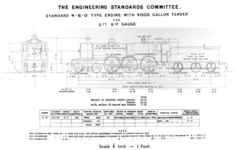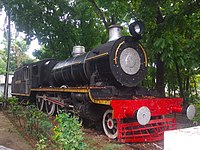
Under the Whyte notation for the classification of steam locomotives, 4-6-2 represents the wheel arrangement of four leading wheels on two axles, six powered and coupled driving wheels on three axles and two trailing wheels on one axle. The 4-6-2 locomotive became almost globally known as a Pacific type after a New Zealand locomotive that was shipped across the Pacific Ocean.

Under the Whyte notation for the classification of steam locomotives, 4-8-2 represents the wheel arrangement of four leading wheels, eight powered and coupled driving wheels and two trailing wheels. This type of steam locomotive is commonly known as the Mountain type, but the New York Central Railroad called their 4-8-2s the Mohawk type.

The Caledonian Railway 812 and 652 Classes were 0-6-0 steam tender locomotives designed by John F. McIntosh for the Caledonian Railway and introduced in 1899. They had the same boiler type as the 721 “Dunalastair” Class 4-4-0s. They could reach speeds of up to 55 mph.
Indian Railways operates India's railway system and comes under the purview of the Ministry of Railways of Government of India. As of 2023, it maintains over 108,706 km (67,547 mi) of tracks and operates over 13,000 trains daily with a fleet of 14,800 locomotives. The railways primarily operates a fleet of electric and diesel locomotives along with a few compressed natural gas (CNG) locomotives. Steam locomotives are operated on mountain railways and on heritage trains.

The LSWR D15 class 4-4-0 was the last steam locomotive design by Dugald Drummond for the London and South Western Railway in 1912. By 1912, Dugald Drummond had built several classes of unsuccessful 4-6-0 express passenger locomotives. The result of these failures was that when he designed what was to be his last class in 1911, a new 4-4-0 design emerged from Eastleigh Works in February 1912, with what was to be the first of his D15 class.

The Class S 3/6 steam locomotives of the Royal Bavarian State Railways were express train locomotives with a 4-6-2 Pacific or 2'C1' wheel arrangement.
The Class S 3/5 engines of the Royal Bavarian State Railways were express train steam locomotives with a 4–6–0 wheel arrangement.
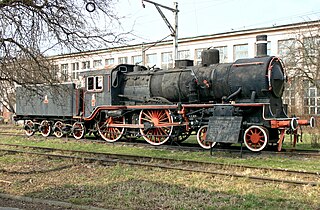
The Prussian S 6 was a class of German steam locomotive with a 4-4-0 wheel arrangement operated by the Prussian state railways for express train services.

The South African Railways Class 19 4-8-2 of 1928 was a steam locomotive.
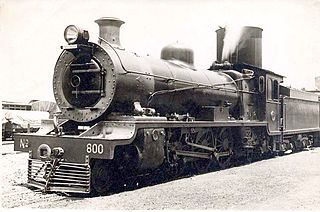
The South African Railways Class 16 4-6-2 of 1914 was a steam locomotive.
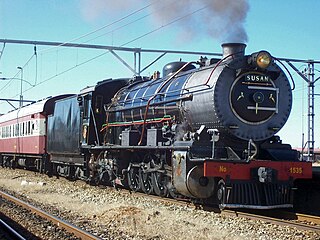
The South African Railways Class 12A 4-8-2 of 1919 was a steam locomotive.
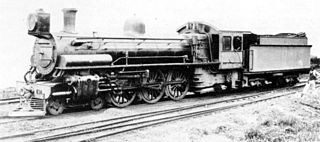
The South African Railways Class 10B 4-6-2 of 1910 was a steam locomotive from the pre-Union era in Transvaal.

The South African Railways Class 6L 4-6-0 of 1904 was a steam locomotive from the pre-Union era in the Cape of Good Hope.

The South African Railways Class 3 4-8-2 of 1909 was a steam locomotive from the pre-Union era in the Colony of Natal.

The South African Railways Class GM 4-8-2+2-8-4 of 1938 was an articulated steam locomotive.

The Caledonian Railway 721 Class was a class of 4-4-0 steam locomotives designed by John F. McIntosh for the Caledonian Railway (CR) and introduced in 1896. All survived to be absorbed by the London, Midland and Scottish Railway (LMS) in 1923 and a few survived into British Railways (BR) ownership in 1948.

SG is the name of a class of Indian steam locomotives used for freight trains. In the designation stands S for Standard, G for Goods. It was by number of built locomotives one of the largest steam locomotive classes built in United Kingdom. The design originated from a BESA standard.

The NS 1700 was a series of express steam locomotives of Nederlandse Spoorwegen and its predecessor Maatschappij tot Exploitatie van Staatsspoorwegen (SS).

The Indian Railways SP class is a class of Indian steam locomotives used for passenger trains which was built around 1905. In the designation SP stands for Standard Passenger. The design originated from a BESA standard.
The AP series was a wide-gauge tender steam locomotive for passenger train service on the railways in British India, which was built around 1907. She is one of the BESA locomotives developed by the British Engineering Standards Committee, later called the British Engineering Standards Association (BESA). The abbreviation AP stands for Atlantic Passenger Locomotive, where Atlantic refers to the axle arrangement of the same name.

